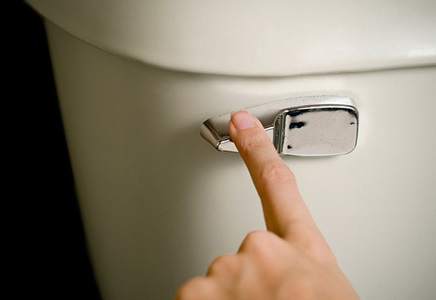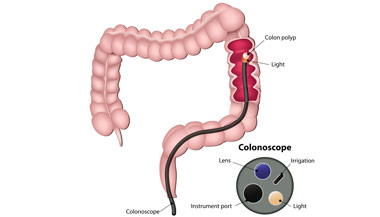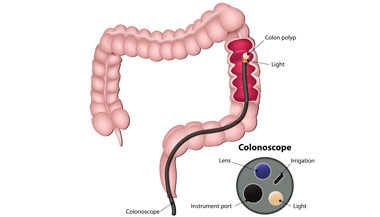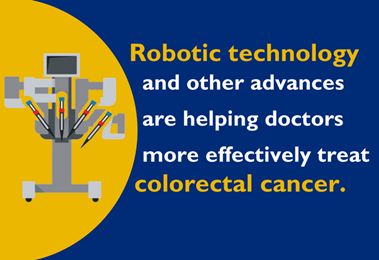Virtual Colonoscopy
What You Need to Know
- Virtual colonoscopy is a special X-ray examination of the colon using low dose computed tomography (CT). It is a less invasive procedure than a conventional colonoscopy.
- A radiologist reviews the images from the virtual colonoscopy to look for polyps on the inside of the colon that can sometimes turn into colon cancer.
- A virtual colonoscopy procedure may be beneficial for patients on blood thinning medications or who may not be candidates for a conventional colonoscopy.
- A virtual colonoscopy only takes 10 to 15 minutes and does not require the use of anesthesia.
Virtual colonoscopy is a procedure that is done to look for small polyps or other growths inside your colon. Polyps that grow on the inside lining of the colon may turn into colon cancer. The American Cancer Society advises that most men and women begin screening for colon cancer at age 50. If you have a family history of colon cancer or are at high risk for other reasons, you may need to have screening even earlier. Virtual colonoscopy every 5 years is 1 of several screening choices.
Procedure overview
Virtual colonoscopy is also called CT colonography. CT stands for computed tomography. A CT scanner takes many X-rays of the colon that are processed by a computer. The computer puts all the X-rays together to create 3-D images of your colon and rectum. These images can then be looked at by your healthcare provider.
Reasons for the procedure
Colon cancer is a common cancer in men and women. The reason for virtual colonoscopy is to find colon cancer at an early stage when it can be treated more easily. Regular colonoscopy is also used to screen for colon cancer. A long, flexible, lighted scope and tiny camera a put into the rectum and up into the colon. This lets the healthcare provider look at the colon directly and remove any polyps that are there. Colon polyps that are found by virtual colonoscopy can be removed with regular colonoscopy before they turn into cancer.
Virtual colonoscopy has some benefits over regular colonoscopy:
-
It is less uncomfortable and invasive. It usually does not need to include any pain medicine or anesthesia.
-
It takes less time.
-
It poses less risk of harming the large intestine.
-
It may be used for some people who are not be able to have regular colonoscopy. In certain cases, it may be used in people who have problems such as swelling, bleeding, or breathing problems.
-
It may be able to show areas of the large intestine that regular colonoscopy can't reach. This may be the case if part of the intestine is narrowed or blocked.
Find an Imaging Location

Risks of the procedure
Every procedure has some risks and possible problems. For virtual colonoscopy, these include:
-
A small, short tube is placed into your anus so that air can be pumped into your colon. This inflates your colon so that polyps or other growths are more easily seen. Pumping air into the colon carries a very small risk that it may cause a tear (rupture). But the risk is thought to be less than with regular colonoscopy.
-
Polyps or other growths cannot be removed or biopsied with a virtual colonoscopy. You will still need to have a regular colonoscopy if polyps or other growths are found.
-
The procedure can miss some polyps if they are smaller than 10 mm. Some of these might be seen by regular colonoscopy.
-
Unlike most other screening tests, the test uses X-rays to create pictures of the colon and rectum. The amount of radiation is small. But it may still raise your risk of cancer slightly. It could also be dangerous for pregnant women. If you are or could be pregnant, talk with your healthcare provider before the procedure.
-
Virtual colonoscopy may not be covered by health insurance.
You may have other risks, depending on your health. Be sure to discuss any concerns with your healthcare provider before the procedure.
5 Things Your Poop Can Tell You About Your Health

Ever curious what bowel changes could signal about your health? Poop may be a gross topic that no one likes to talk about, but taking a quick peek before you flush may give you clues about your health.
Before the procedure
Tell your healthcare provider about any medicines you are taking. Before having a colonoscopy, you will need to have a bowel prep. A bowel prep helps you empty your colon so that the CT images will be clear. Here is how bowel prep is often done:
-
Your healthcare provider may ask you to limit your diet to clear liquids for 1 or 2 days before the procedure. These might be water, clear broth, or an electrolyte solution.
-
The day before the procedure, you will be given a strong laxative in pill or liquid form to help you empty your colon. You will likely have several loose or liquid bowel movements in the next hours.
-
Just before the procedure you may be given a type of liquid to drink. This is called contrast media. It helps the inside of your colon show up more clearly for the X-rays. Tell your provider if you've had any reactions to contrast media in the past.
During the procedure
Virtual colonoscopy can be done wherever a CT scanner is used. In most cases it is done in the radiology department of a hospital or medical center. The scan takes only about 10 to 15 minutes. This is what happens during the test:
-
The thin tube will be placed into your rectum. This is used to inflate your colon with air. You may feel a slight fullness.
-
A radiologist will put you face up on a table that slides into the CT scanner.
-
The radiologist will leave the room. The CT scanner will be operated from a separate control room. You will be able to hear and talk with the staff.
-
The table will move into and through the scanner. You may hear some whirring and clicking noises.
-
You may be asked to hold your breath at times.
-
The scan may need to be repeated while you lie face down.
After the procedure
In most cases, you should be able to return home without help. You can go back to your normal diet and activities. You will likely not need medicines or special instructions. Talk with your healthcare provider and the radiology staff if you have any questions.
Virtual Colonoscopy Q&A | Dr. Karen Horton
Virtual colonoscopy is a minimally invasive alternative to conventional colonoscopy (endoscopy) that screens the colon and rectum for polyps and early cancer before symptoms occur. Karen Horton, M.D., professor and chair of Radiology, discusses what is involved in the procedure, how to prepare and the benefits of virtual colonoscopy over conventional colonoscopy.







